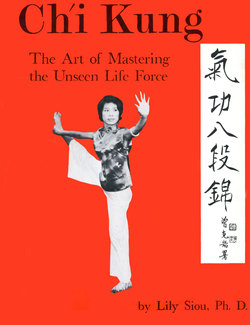Читать книгу Chi Kung - Lily Siou - Страница 9
ОглавлениеCh'i Kung: The art of mastering
the unseen life force
Table of contents
| PART I | ||
| The Concept of Breathing Control—Pao Po Tzu, by Dr. Ko Hung, 470 B.C. | 3 | |
| 1. | Body Energy or the Unseen Life Force | 7 |
| 2. | Chinese Concept of Ch'i and Kung | 9 |
| 3. | Theory and Philosophy Behind the Art of Ch'i Kung | 12 |
| Ch'i Kung and the beginning of the world—form/force/substance and dual power.—Primitive man and the early stages of ch'i kung development. | ||
| 4. | Ch'i Kung and the Yin & Yang | 15 |
| Ch'i Kung, the Tao and the interplay of the Yin & Yang.—Human body according to Chinese physiology.—Ch'i Kung and the Tao. | ||
| 5. | Chinese Concept of Healing | 19 |
| Law of the universe and the Chinese concept of healing.—Acupuncture. | ||
| 6. | Great Herbal: A complete and Scientific Work on Chinese Medicine by Dr. | |
| Li Shih Chen, Ming Dynasty | 22 | |
| 7. | History of Chinese Medicine | 25 |
| Shen Nung: Legendary emperor & "Father of Medicine.":—Huang Ti: Legendary Emperor & "author" of Nei Ching, the Yellow Emperor's Classic of Internal Medicine.—History's first successful heart transplant, 3rd C., B.C.—Hua T'o, China's last great surgeon, 3rd C., A.D.—Priest doctors. | ||
| 8. | Two Doctrines | 27 |
| Creativity in Chou Dynasty.—Scholastic stagnation in medicine before Middle Chou. —Doctrine of Yin & Yang.—Doctrine of the Five Elements.—Art of Pulse Reading. | ||
| 9 | Five Cardinal Rules for Chinese Doctors | 32 |
| 10. | Ch’i Kung & the Taoist | 33 |
| Legends and the emulation of nature.—Lao Tzu.—Chuang Tsu.—Chang Tao Ling, Sorcerer of the Mountain of the Dragon and Tiger.—Shan T'an, the Mountain of Elixer. | ||
| 11. | Ch'i Kung and the Martial Arts | 36 |
| Being one with nature.—Principles of the Tao applied to combat.—Ultimate self defense.—Internal energy called ch'i.—Resource for betterment. | ||
| 12. | CH'i Kung: A Needed Development | 41 |
| PART II | ||
| 1. | Principles of Ch'i Kung | 47 |
| Form-Force-Substance.—Relaxation.—Tranquility.—Concentration.—Motion.—Inward & Outward Modes of Motion.—Importance of respiratory control.—Harmony of action and non-action, or motion and tranquility. | ||
| 2. | Practice of Ch'i Kung | 53 |
| Breathing control and important aspects of Ch’i Kung.—Energy areas of the body.—Practice and results. | ||
| 3. | Sensations Felt During Practice | 58 |
| Flowing of body energy.—Peace and comfort.—Tingling.—Increase of Saliva.—Heaviness or thirst and dryness due to incorrect breathing control.—Visual phenomena.—Dizziness.—Important things to realize. | ||
| 4. | Experience of a Ch'i Kung Practitioner | 61 |
| Colored lights and mind music.—Patterns of being. | ||
| 5. | Ch'i Kung and the Functioning of the Organs | 66 |
| Digestive system: achieving one's correct weight naturally.—Self regulation.—Traditional Chinese dietetics.—Circulatory system: enriched blood system.—Other organs: well being peace of mind and sleep. |
| PART III | ||
| THE ART OF EIGHT SILKEN FORMS | ||
| Preliminary | ||
| Instructions | Beginning Meditation for Tranquility | 74 |
| THE SITTING FORMS | ||
| Form I | The Blooming of Spring | 75 |
| Form II | Lighting the Back Burning Spaces | 78 |
| Form III | Extending the Wings & Twisting the Neck | 83 |
| Form IV | Holding the Warm Jade Pillow | 87 |
| Form V | Sounding the Ancient Drums | 90 |
| Form VI | Chewing with Both Wings Upward | 93 |
| Exchanging Form | The Graceful Pheonix (taking the legs out) | 95 |
| Form VII | Circling the Heavens | 98 |
| Form VIII | Polishing the Wheels | 101 |
| Exchanging Form | The Ascending Dragon (standing up) | 104 |
| THE STANDING FORMS | ||
| Salutation (hot included in this book) | ||
| Form I | The Preliminary | 112 |
| Form II | Supporting Heaven with Both Hands | 114 |
| Form III | Pointing Out the Eagle | 116 |
| Form IV | Reviewing the Four Quarters | 123 |
| Form V | Forming the Force | 130 |
| Form VI | Upon a Divine Horse | 137 |
| Form VII | The Gentle Fist | 143 |
| Form VIII | Welling the Life Roots | 148 |
